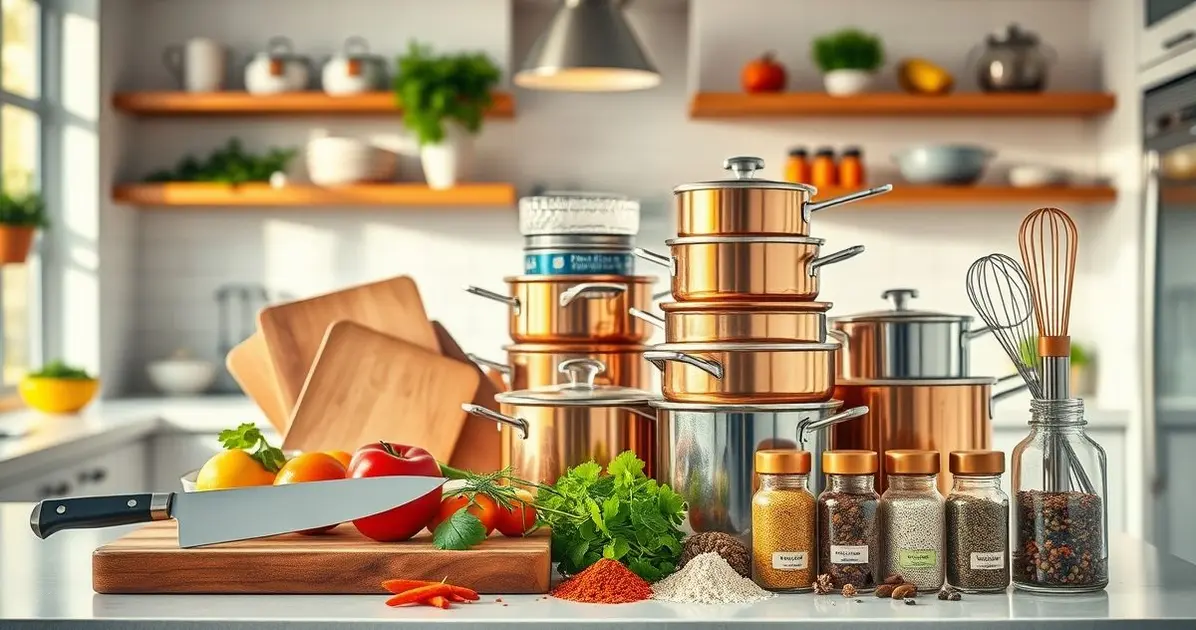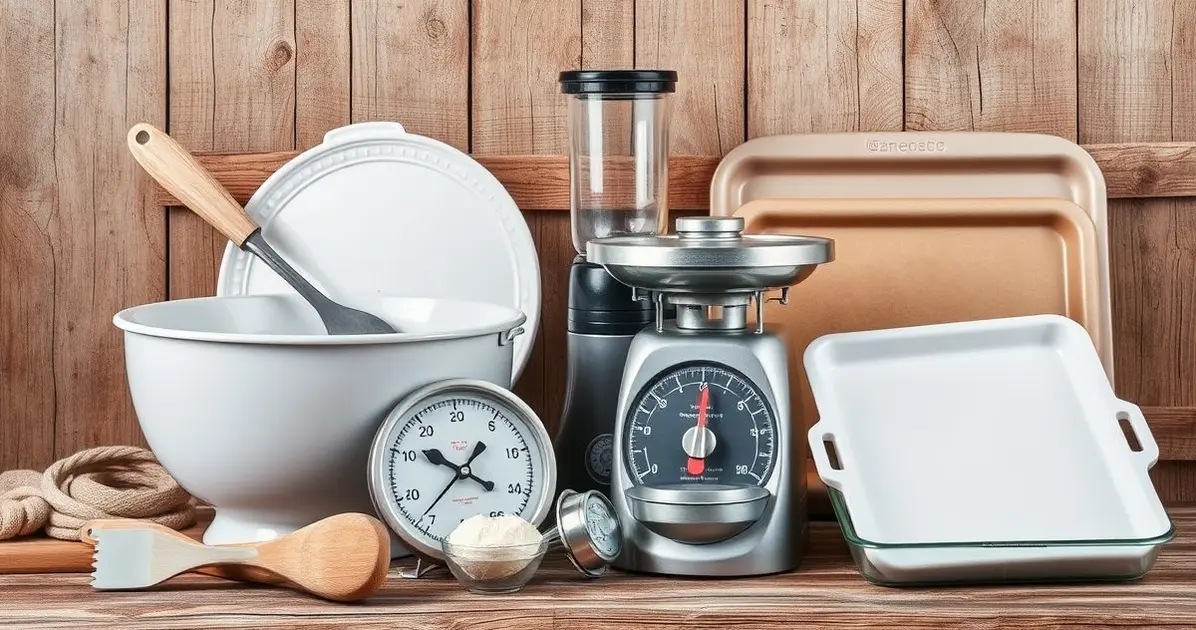Cooking requires various tools and equipment to ensure efficiency and creativity in the kitchen. From basic utensils to specialized appliances, each plays a crucial role in meal preparation.
What are the tools and equipment needed in cooking

The right tools and equipment are vital for any cooking endeavor. Essential items include knives, cutting boards, pots, pans, and measuring utensils, along with appliances like blenders and mixers. Together, they form the foundation of successful cooking.
Overview of Basic Cooking Utensils
Basic cooking utensils are fundamental tools that every kitchen should have. These utensils enhance efficiency in food preparation and ensure that tasks are performed safely and effectively. Here’s an overview of basic cooking utensils:
1. Chef’s Knife:
- Versatility: The chef’s knife is a multipurpose tool used for chopping, slicing, and dicing a variety of ingredients. Its broad blade allows for a rocking motion, making it ideal for quick and efficient cutting.
2. Paring Knife:
- Precision: A paring knife is smaller than a chef’s knife and is perfect for intricate tasks such as peeling fruits and vegetables or removing seeds. It offers greater control for detailed work.
3. Cutting Boards:
- Safety: Cutting boards provide a safe surface for chopping and slicing. It’s advisable to use separate boards for raw meats and vegetables to prevent cross-contamination.
4. Mixing Spoons:
- Material Variety: Mixing spoons come in various materials, including wood, silicone, and stainless steel. They are essential for stirring and combining ingredients.
5. Spatulas:
- Types: Spatulas come in various forms, including turners for flipping food and rubber spatulas for scraping bowls. A good set of spatulas is essential for cooking and baking tasks.
6. Whisks:
- Mixing and Aerating: Whisks are ideal for beating eggs, mixing batter, and incorporating air into mixtures. They come in various sizes and materials to suit different tasks.
7. Ladles:
- Serving Soups and Sauces: Ladles are perfect for serving soups, stews, and sauces. They allow for easy portioning and serving of liquid-based dishes.
8. Tongs:
- Versatile Handling: Tongs are handy for flipping, turning, and serving food. They provide a secure grip on ingredients and are especially useful for grilling, frying, or tossing salads.
By equipping your kitchen with these basic cooking utensils, you can enhance your cooking efficiency and make food preparation more enjoyable. Each tool serves a specific purpose, contributing to the overall success of your culinary endeavors!
Importance of Cookware in Cooking
The importance of cookware in cooking is crucial for achieving optimal results in your culinary endeavors. The right cookware not only enhances cooking performance but also affects the quality of the food you prepare. Here are several reasons why cookware is vital:
1. Heat Distribution:
- Even Cooking: Quality cookware is designed to distribute heat evenly, preventing hot spots that can burn food. This ensures that your ingredients are cooked thoroughly and consistently.
- Material Impact: Different materials, such as stainless steel, cast iron, and non-stick, each have unique heat conductivity properties that influence cooking times and techniques.
2. Cooking Techniques:
- Versatility: Cookware allows for various cooking methods, including boiling, frying, sautéing, and baking. Choosing the right type of cookware for each method is essential for achieving the desired results.
- Specialized Cookware: Certain dishes require specific types of cookware, such as a Dutch oven for braising or a non-stick skillet for frying delicate foods.
3. Food Quality:
- Flavor Development: Proper cookware can enhance the flavors of your dishes. For example, cast iron cookware can add depth to the taste of stews and braised meats due to its heat retention properties.
- Texture Improvement: The right cookware helps to achieve the desired texture in your food, whether it’s a crispy crust on a roast or perfectly steamed vegetables.
4. Safety Considerations:
- Non-Reactive Materials: Using non-reactive cookware, such as stainless steel or glass, ensures that no harmful chemicals leach into your food, maintaining food safety.
- Heat Resistance: Quality cookware is designed to withstand high temperatures without warping or releasing harmful substances.
5. Ease of Use and Maintenance:
- Durability: High-quality cookware is built to last, reducing the need for frequent replacements. Proper care and maintenance can keep your cookware in excellent condition for years.
- Easy Cleanup: Many modern cookware options are designed for easy cleaning, making post-cooking cleanup quick and convenient.
In summary, the importance of cookware in cooking cannot be overlooked. By choosing the right cookware for your culinary needs, you can enhance your cooking performance, improve food quality, and create a safer cooking environment. Investing in quality cookware is a step towards achieving culinary excellence!

Specialized Gadgets for Culinary Masterpieces
Specialized gadgets can significantly enhance your ability to create culinary masterpieces by simplifying complex tasks and improving overall cooking efficiency. Here’s a look at some specialized gadgets for culinary masterpieces:
1. Food Processor:
- Versatility: A food processor can chop, slice, shred, and puree ingredients quickly, making it an invaluable tool for meal prep and allowing you to create complex dishes with ease.
- Attachments: Many food processors come with various attachments, such as slicing disks and dough blades, enabling you to perform a wide range of tasks.
2. Immersion Blender:
- Convenience: An immersion blender allows you to blend soups and sauces directly in the pot, eliminating the need to transfer hot liquids to a traditional blender.
- Easy Cleanup: Since you can blend directly in the cooking vessel, cleanup is much faster and simpler, making it easier to enjoy cooking.
3. Mandolin Slicer:
- Uniform Slicing: A mandolin slicer allows for quick and consistent slicing of vegetables and fruits, which enhances presentation and cooking efficiency.
- Adjustable Thickness: Many mandolins come with adjustable settings, allowing you to slice ingredients to your desired thickness, perfect for salads or garnishes.
4. Instant Pot:
- Multi-Functionality: The Instant Pot combines several cooking methods, including pressure cooking, slow cooking, and sautéing, making it a versatile tool for busy kitchens.
- Time Efficiency: It significantly reduces cooking times for dishes that typically take hours, such as stews or braised meats, allowing for quick meal preparation.
5. Spiralizer:
- Creative Vegetable Preparation: A spiralizer transforms vegetables like zucchini and carrots into noodle-like shapes, offering a fun and healthy alternative to traditional pasta.
- Enhancing Presentation: Spiralized vegetables add visual appeal to dishes, making them more attractive and inviting for guests.
6. Kitchen Scale:
- Precision Measurement: A kitchen scale is essential for accurate measurements, especially in baking where precision is key to achieving the desired results.
- Portion Control: It helps in managing portion sizes, ensuring balanced meals and reducing food waste.
7. Digital Thermometer:
- Cooking Accuracy: A digital thermometer provides quick and accurate temperature readings, ensuring meats are cooked to the right temperature for safety and flavor.
- Versatile Use: It can also be used for candy making, baking, and checking the temperature of liquids.
8. Silicone Baking Mats:
- Non-Stick Surface: Silicone mats provide a non-stick surface for baking, making it easy to remove baked goods without sticking.
- Reusable: They are eco-friendly alternatives to parchment paper and can be used multiple times, saving money in the long run.
By incorporating these specialized gadgets into your kitchen, you can streamline your cooking process and elevate your culinary skills. Each gadget serves a specific purpose, making cooking more enjoyable and efficient, whether you’re preparing a simple meal or an elaborate feast!
Measuring Tools for Precision Cooking
Measuring tools are essential for precision cooking, ensuring that ingredients are accurately measured for consistent results. Here’s a detailed overview of measuring tools for precision cooking:
1. Measuring Cups:
- Types: Measuring cups come in both liquid and dry varieties. Liquid measuring cups are typically made of glass or plastic and have spouts for easy pouring, while dry measuring cups are available in sets to measure various quantities.
- Usage: Use measuring cups for accurately measuring ingredients like water, milk, flour, and sugar. Fill to the brim and level off for dry ingredients to ensure accuracy.
2. Measuring Spoons:
- Essential for Small Quantities: Measuring spoons are used for measuring smaller amounts of ingredients, such as spices, extracts, and baking powder.
- Common Sizes: Standard sets typically include teaspoons and tablespoons, allowing for precise measurements in recipes.
3. Kitchen Scale:
- Precision Measurement: A kitchen scale is vital for accurate measurements, especially in baking where ingredient ratios are crucial.
- Types: Digital scales provide quick and accurate readings, and many allow you to switch between metric and imperial units for convenience.
- Portion Control: Using a scale helps in managing portion sizes, ensuring balanced meals and reducing food waste.
4. Liquid Measuring Tools:
- Graduated Measuring Cups: These cups are specifically designed for measuring liquids and often have clear markings for easy reading.
- Pour Spouts: Many liquid measuring cups come with pour spouts to minimize spills when transferring liquids.
5. Thermometers:
- Digital Thermometers: While primarily used for measuring temperature, they can also be used to ensure that liquids are at the right temperature for specific recipes, such as when making candy or tempering chocolate.
6. Importance of Accuracy:
- Consistency: Accurate measurements ensure that your recipes turn out consistently, which is especially important in baking where precision is key.
- Flavor Balance: Proper measurements of spices and flavoring ingredients help enhance the overall taste of your dishes, ensuring that flavors are balanced.
In summary, utilizing measuring tools for precision cooking is essential for achieving accurate and consistent results in the kitchen. By incorporating these tools into your cooking routine, you can enhance your culinary skills and ensure that your dishes are prepared to perfection!
Conclusion
In conclusion, measuring tools are indispensable for precision cooking, ensuring that your ingredients are accurately measured for consistent and successful results.
Whether you are using measuring cups, spoons, or a kitchen scale, each tool plays a vital role in achieving the desired outcome in your recipes.
Understanding the importance of accurate measurements not only enhances the quality of your dishes but also promotes food safety and efficiency in the kitchen.
By utilizing these measuring tools, you can create balanced flavors and maintain consistency in your cooking, whether you’re baking a cake or preparing a savory dish.
Investing in quality measuring tools and incorporating them into your cooking routine will elevate your culinary experience, making it more enjoyable and rewarding.
Embrace the art of precision cooking, and watch your culinary skills flourish!
FAQ – Frequently Asked Questions about Measuring Tools in Cooking
Bakit mahalaga ang mga measuring tools sa pagluluto?
Mahalaga ang mga measuring tools upang matiyak na ang mga sangkap ay tumpak na nasusukat, na nagreresulta sa pare-parehong resulta sa mga recipe.
Anong mga uri ng measuring tools ang dapat mayroon sa kusina?
Dapat mayroon kang measuring cups, measuring spoons, at kitchen scale para sa tumpak na pagsukat ng mga sangkap.
Paano ko dapat gamitin ang measuring cups para sa mga liquids?
Gamitin ang liquid measuring cups na may spout, punuin ito hanggang sa marka, at tingnan ang antas mula sa mata upang matiyak na tama ang sukat.
Ano ang pagkakaiba ng measuring cups at measuring spoons?
Ang measuring cups ay ginagamit para sa mas malalaking sukat ng mga sangkap, habang ang measuring spoons ay ginagamit para sa mas maliliit na dami, tulad ng spices at extracts.
Bakit mahalaga ang kitchen scale sa pagluluto?
Ang kitchen scale ay nagbibigay ng tumpak na sukat, na mahalaga lalo na sa baking kung saan ang tamang ratio ng mga sangkap ay susi sa tagumpay ng recipe.
Paano ko mapapanatiling malinis ang aking measuring tools?
Linisin ang mga measuring tools gamit ang mainit na tubig at mild soap pagkatapos gamitin, at siguraduhing tuyo ang mga ito bago itago.
See more
Discover plenty of easy and delicious recipes you can make at home, from hearty dinners to indulgent desserts and wholesome breakfasts.




